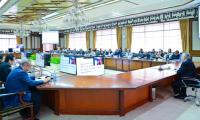The present surge of inflation arises from the intersection of the crisis triggered by the pandemic with the decades of policies promoting the growth of social inequality. For decades, the US government and political establishment sought to overcome the crisis of American capitalism through the impoverishment of the working class, coupled with the provision of unlimited cash for the financial elite.
In 1979, the Carter administration appointed Paul Volcker to the chairmanship of the Federal Reserve. Volcker moved to raise interest rates to historic levels in order to break the resistance of the working class.
With the election of Reagan in 1980 this assault was intensified. Gaining assurances from the AFL-CIO that the unions would not interfere, Reagan crushed a strike of air traffic controllers in August 1981. The betrayal by the AFL-CIO initiated a wave of defeats for workers, as the trade union bureaucracy morphed into low-wage labor contractors, functioning to police the working class for the benefit of their increasingly wealthy and corrupt executives.
But the underlying economic crisis of American capitalism driving these policies only deepened. The Federal Reserve encouraged speculation and debt to keep asset bubbles going. In crisis after crisis, beginning in 1987, the government intervened to buy toxic assets, lower interest rates, and funnel money into financial markets. The wealth of the upper classes ballooned, tethered to rising stock prices.
This policy came to a head in 2008. Toxic subprime mortgage assets in the US imploded, engulfing the entire world economy. In response, the Federal Reserve, and other central banks, took unprecedented measures to prop up capitalist markets. Bush and Obama funneled trillions of dollars into financial markets, bailed out Wall Street directly, refused to prosecute those responsible, and restructured American manufacturing by gutting pay and benefits in the auto industry.
By 2020, the trillions of dollars of cash injected into financial markets in response to 2008 had led to record highs in the stock market.
While the pandemic temporarily disrupted these gains, the response of the ruling class has been to orchestrate another massive bailout of the rich. The Federal Reserve initiated an emergency program of asset purchasing. Some $4.5 trillion of digitally printed money has been used to prop up financial markets. Asset purchases continue to the tune of $120 billion every month. In addition to this, the CARES act, which cost $2.3 trillion, was largely a bailout of major corporations and businesses, many of which received billions of dollars in direct aid.
This free money has fueled a massive inflation in the value of all financial assets and the wealth of the rich.
The financial oligarchy that dictates social and political life in the United States is determined that the entire burden of the crisis triggered by the pandemic should be borne by the working class. This overriding concern led to the coverup of the dangers posed by COVID-19 in early 2020, then the systematic abandonment of public health measures beginning in late March, followed immediately afterward by the slashing of emergency jobless aid, with the aim of forcing workers to accept any job, no matter how unsafe or low-wage, that they can get.
But despite the ruling class’s efforts to force workers into disease-ridden factories and warehouses, the pandemic, coupled with the international tensions it intensified, has had a major impact on global supply chains. Many workers with health conditions, or whose family members are immunocompromised, have chosen not to return to poverty-wage jobs amid a raging pandemic.
The ruling class is concerned that the growing demands of workers for higher wages, expressed in both strikes and the so-called ‘great refusal’, that is low-wage workers leaving their jobs, has led to significant labor shortages in key sectors.
The surging cost of living has propelled the largest strike wave in decades, including major struggles at Volvo, Deere, Dana and elsewhere.
In each of these struggles, the workers confront not only their employers, but the trade unions, which have worked to systematically isolate, sabotage and shut down every strike. If these organizations of scabs had their way, the class struggle in 2021 would proceed the way it had in decades past: with plummeting wages, mass layoffs and soaring corporate profits.
But at factories, hospitals and schools across the country, new rank-and-file committees are forming which represent the genuine interests of workers. To succeed, these organizations must, through coordinated action, break through the isolation imposed on them by the trade unions. This means forming bonds and links with workers in other sectors, other states and, critically, other countries.
Faced with the growth of the class struggle, sections of the political establishment are considering solving the “labor problem” by force, with Biden saying last month that he is considering deploying the National Guard to “get the ports up and running.”
Since the start of the pandemic, the US ruling class has sought to ensure that the entire cost of the crisis, whether in death or economic suffering, must be borne by the working class, even as the world’s billionaires pile up immeasurable fortunes.
But enough is enough. It is not America’s exploited and impoverished workers – who have been told for decades that they must accept layoffs and pay cuts for the good of American industry – but America’s financial oligarchy that must bear the cost of a health, social and economic crisis created by American capitalism.
Excerpted: ‘The surging cost of living and the class struggle’
Wsws.org
While these films are fictional, parallels between their narratives and real world discussions about AI are hard to...
Despite their numbers, young voices are often sidelined
Depositors who want to profit from their savings will transfer their money to banks to invest in any business venture
Not surprisingly, our youth see no hope for the future
The post-election situation will be troublesome and worrisome for Modi
Most favourable concept developed so far revolves around public-private partnerships






